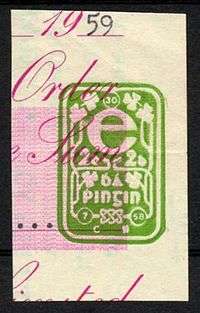Taxation in Denmark
The income tax in Denmark was introduced in 1903 and is now divided into a state income tax and a local income tax. The state income tax is a progressive tax while the local income tax is a flat tax.
Income tax
All income from employment or self-employment is taxed at 8% before income tax. This tax is termed a "gross tax" (Danish: Arbejdsmarkedsbidrag). Income below DKK 42,800 (USD 7,600) (2014-level, adjusted annually) is income tax-free, but subject to the gross tax.[1]
Interest paid up to DKK 50,000 is tax deductible. Commuting exceeding 24 kilometers/day receives a DKK 2.05 per kilometer tax deduction. For commutes exceeding 100 kilometers per day, the rate is reduced to DKK 1.03 per kilometer.[2] A number of other deductions apply. The general rule is that the taxpayer is able to deduct his/her expenses in acquiring their taxable income, although there are many exceptions to this rule. Employees have very limited possibilities for tax deduction as it is assumed that the employer covers the expenses related to the employee's work. The employer will then be able to deduct most of these expenses from his own taxable income. Furthermore, Union Fees are tax deductible.
The state income tax has two income brackets (base and top). In 2014 income from DKK 42,900 to DKK 421,000 is taxed at 5.83% and income above DKK 422,000 is taxed an additional 15%. Other taxes include Municipal income tax, currently in the range 23% - 28%, though on average 24.09%. A Health contribution tax (3% (2016);2% (2017);1% (2018);0% (2019)) apply on all income above the tax free allowance in year 2014, though from there the health contribution is getting merged with the regular income tax by one percent per year. From 1 January 2019 there will be no health tax as it will then have been phased out, by then being part of the income taxes that everyone pays. Under the Danish tax system, it is possible for a high-wage earner to pay up to 51.5% of their total income after gross tax, giving a total of 57% of total income.
Land value tax
The Danish ejendomsskat (or Municipal Property Tax) is a land value tax, which taxes the base value of the land according to either:
- The total value of the property minus the value of improvements or
- The value of the property last tax year, altered by a growth/decline percentage.
Whichever of those two assessments is lower results in the base land value.[3][4] This base land value is taxed at between 1.6 and 3.4% in 2013,[4] although some individual properties may pay more or less.
Proceeds from selling ones home - if there is any home equity (Danish: friværdi) - are not taxed, as the marginal tax rate on capital income from housing savings is around 0 percent.[5]
Local income taxes and other income taxes
The local income tax varies from municipality to municipality. The highest local income tax in 2009 is 27.80% and the lowest is 22.70%.[6]
The regional health care tax (Danish: Sundhedsbidrag) was 8% when it was introduced from 1 January 2007. It is set and handled by the central government, as the regions never have had the right to levy taxes independently unlike the counties. This tax will be phased out by 1 January 2019. 2016 it stands at 3%.
Maximum income tax level
The sum of all income tax percentages (municipal income tax, state income taxes and the central government income tax financing health care in the Regions called health care contribution (Danish: Sundhedsbidrag)) cannot exceed 51.5%.[7]
On top of the other taxes, members of the Danish National Church pay an additional 0.4% to 1.5% church tax. The rate depends on the municipality. While the church is a state institution, the church tax does not count toward the maximum 59% marginal tax, and one can be exempted from paying this tax by opting out of being a member of the state church.
VAT
| Year | VAT level (Denmark) |
Name |
|---|---|---|
| 1962 | 9% | OMS |
| 1967 | 10% | MOMS |
| 1968 | 12.5% | MOMS |
| 1970 | 15% | MOMS |
| 1977 | 18% | MOMS |
| 1978 | 20.25% | MOMS |
| 1980 | 22% | MOMS |
| 1992 | 25% | MOMS |
Denmark has a non-deductible value added tax (VAT) of 25%,[8] - MOMS (Danish: merværdiafgift, formerly meromsætningsafgift). The tax is subject to the European Union value added tax Directives.
In Denmark, VAT is generally applied at one rate, and with few exceptions is not split into two or more rates as in other countries (e.g. Germany), where reduced rates apply to essential goods such as foodstuffs. The current standard rate of VAT in Denmark is 25%.[9] VAT in Denmark is one of the highest rates, alongside Norway and Sweden. A number of services have reduced VAT, for instance public transportation of private persons, health care services, publishing newspapers, rent of premises (the lessor can, though, voluntarily register as VAT payer, except for residential premises), and travel agency operations.
References
- ↑ http://www.skat.dk/SKAT.aspx?oId=133800
- ↑ http://www.skat.dk/SKAT.aspx?oId=1988906
- ↑ http://www.tax.dk/pjecer/ejendomsskat.htm
- 1 2 http://www.skat.dk/SKAT.aspx?oId=1648149
- ↑ Danish Economic Councils Spring Report 2008 English Summary, p. 11
- ↑ "SKAT.dk". The Danish Ministry of Taxation. Retrieved 2009-01-16.
- ↑ "SKAT.dk". The Danish Ministry of Taxation. Retrieved 2010-07-18.
- ↑ VAT in Denmark, p. 4.
- ↑ "VATGlobal".

